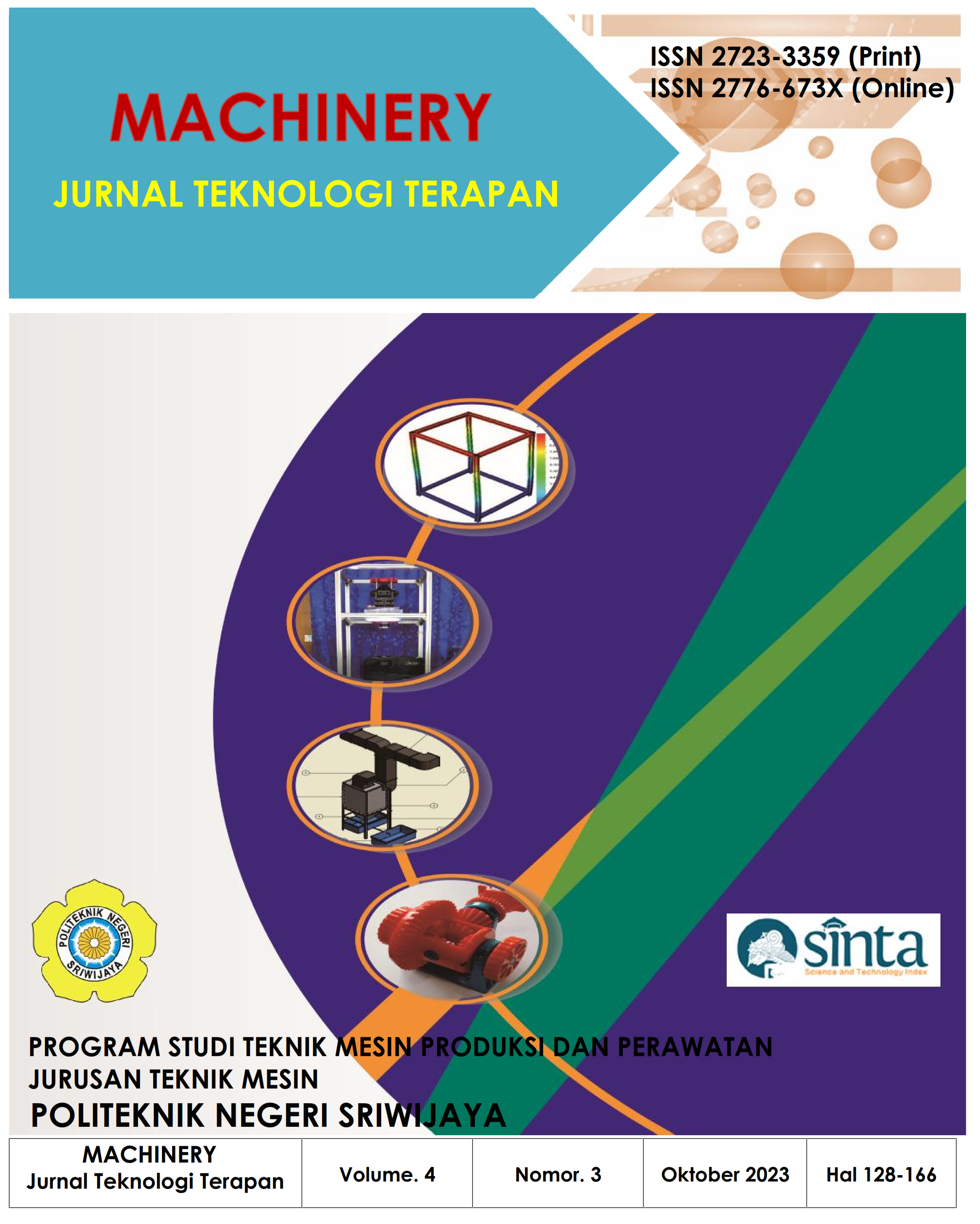DESAIN JUMLAH TABUNG DAN SENSOR DALAM RANCANG BANGUN FIRE SUPPRESSION SYSTEM
DOI:
https://doi.org/10.5281/zenodo.10122201Keywords:
Sensor, Pemadam kebakaran, TabungAbstract
The industrial sector is at high risk of fire hazards, so a system is needed to protect assets and workers. This research aimed to develop an effective system. The study used a method that utilized the effectiveness of an infrared sensor in a 300 square meter room. The sensor was placed 1 to 7 meters from the candle flame. The results showed that the room was highly effective if five sensors were installed, each at a radius of 4 meters, and two fire extinguishing system tubes were mounted on a 3-inch diameter pipe. The system's response time was still within the standard 10 seconds.
Downloads
References
Aji, A. S. B., Ismail, K. M. & others, 2020. Rancangan Clean Agent Fire Suppression System Di Ruang Panel Chiller Terminal 1 Bandar Udara International Juanda Dengan Luas Ruangan 29, 43 Meter. Langit Biru: Jurnal Ilmiah Aviasi, Volume 13, p. 223–232. (https://journal.ppicurug.ac.id/index.php/jurnal-ilmiah-aviasi/article/view/130)
Du, Y., Mao, X., Xu, D. & Ren, F., 2012. Analyzing the effects of failure on fire equipment in building by FAST. Procedia Engineering, Volume 45, p. 655–662. (https://doi.org/10.1016/j.proeng.2012.08.218)
Hu, J.-w. & Chen, S.-s., 2014. Analysis of Security Evacuation Simulation and Optimization of a University Library. Procedia Engineering, Volume 71, pp. 558-566. (https://doi.org/10.1016/j.proeng.2014.04.080)
Huo, F. et al., 2016. Experimental study on characteristics of pedestrian evacuation on stairs in a high-rise building. Safety science, Volume 86, p. 165–173. ( https://doi.org/10.1016/j.ssci.2016.02.025)
Khattri, S. K., 2017. From small-scale tunnel fire simulations to predicting fire dynamics in realistic tunnels. Tunnelling and Underground Space Technology, Volume 61, p. 198–204. (https://doi.org/10.1016/j.tust.2016.10.010)
Lee, E.-J., Ruy, W.-S. & Seo, J., 2020. Application of reinforcement learning to fire suppression system of an autonomous ship in irregular waves. International Journal of Naval Architecture and Ocean Engineering, Volume 12, p. 910–917. ( https://doi.org/10.1016/j.ijnaoe.2020.11.001)
Li, M.-x., Zhu, S.-b., Wang, J.-h. & Zhou, Z., 2018. Research on fire safety evacuation in a university library in Nanjing. Procedia engineering, Volume 211, p. 372–378. (https://doi.org/10.1016/j.proeng.2017.12.025)
Long, M., 2009. Numerical Simulation of College Dormitory Fire Based on FDS. Safety and Environmental Engineering. ( https://doi.org/10.1016/j.firesaf.2019.04.004)
McNeil, J. G. & Lattimer, B. Y., 2017. Robotic fire suppression through autonomous feedback control. Fire technology, Volume 53, p. 1171–1199. (https://link.springer.com/article/10.1007/s10694-016-0623-1)
Miyashita, T. et al., 2014. Modeling and analysis of water discharge trajectory with large capacity monitor. Fire safety journal, Volume 63, p. 1–8. (https://doi.org/10.1016/j.firesaf.2013.09.028)
Qiang, L. I. A. N. G. & Hong-yu, J. I. N., 2011. The Study on Safety Evaluation of Evacuation in a Large Supermarket. Procedia Engineering, Volume 11, p. 273–279. (https://doi.org/10.1016/j.proeng.2011.04.657)
Yoon, S.-H., Lee, M.-J. & Yee, J.-J., 2013. An experimental study on evacuation times in a subway station using evacuation parameters. Journal of Asian Architecture and Building Engineering, Volume 12, p. 93–100. (https://doi.org/10.3130/jaabe.12.93)
Downloads
Published
How to Cite
Issue
Section
License
Copyright (c) 2023 Authors and Publisher

This work is licensed under a Creative Commons Attribution-NonCommercial-NoDerivatives 4.0 International License.
The Authors submitting a manuscript do so on the understanding that if accepted for publication, copyright of the article shall be assigned to MACHINERY: Jurnal Teknologi Terapan as publisher of the journal. Copyright encompasses rights to reproduce and deliver the article in all form and media, including reprints, photographs, microfilms, and any other similar reproductions, as well as translations.Â
MACHINERY: Jurnal Teknologi Terapan and the Editors make every effort to ensure that no wrong or misleading data, opinions or statements be published in the journal. In any way, the contents of the articles and advertisements published in MACHINERY: Jurnal Teknologi Terapan are the sole responsibility of their respective authors and advertisers.








